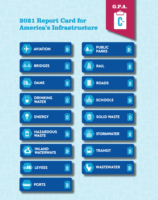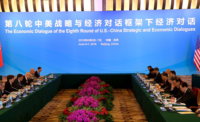Infrastructure boosters rallied for their cause earlier this month at a series of gatherings in Washington, D.C. and other U.S. locations to find ways to shrink the estimated $1.4-trillion funding gap to upgrade aging highways, bridges, water systems and other public works. But it remains unclear how much impact the high-level interchanges will have on federal legislation in this election year.
Infrastructure advocates must wait until 2020 for another crack at funding gains for highways and transit, the sector with the deepest deficit—$1.1 trillion, the American Society of Civil Engineers estimates.Signed last December, the $305-billion Fixing America’s Surface Transportation Act locks in higher authorizations for five years, but with increases that industry officials find disappointingly modest.
But the conferences—among numerous “Infrastructure Week” events held May 16-23 across the U.S.—may help other bills not yet at the finish line, says Brian Pallasch, ASCE managing director for government relations and infrastructure initiatives. “It’s not just roads and bridges, obviously, that we need to talk about,” he says.
Pallasch points to the $11-billion Water Resources Development Act (WRDA), which a Senate committee cleared on April 28. It has $5 billion for new Army Corps of Engineers civil-works projects, the law’s traditional centerpiece. It also funds U.S. Environmental Protection Agency wastewater and drinking-water programs. That could help cities with deteriorated systems, such as in Flint, Mich. House transportation panel Chairman Bill Shuster introduced a $5-billion WRDA bill on May 23 that authorizes only Corps projects (see p. 6).
Airport infrastructure also may get a legislative lift this year. The Senate on April 19 passed a Federal Aviation Administration reauthorization with a strong 12% hike for airport construction grants, although just for 2017. A House committee cleared a six-year FAA bill in February, with a 7% airport-grant increase in 2017 and annual boosts after that. But that bill has stalled in the wake of criticism about a provision to spin off FAA air-traffic-control operations.
Some Infrastructure Week speakers continued to have their eye on highways and transit but were looking beyond this year. Former U.S. Transportation Secretary Ray LaHood, speaking with other ex-DOT chiefs, called on the next president and new Congress to consider a much larger infrastructure stimulus bill, totaling “maybe $500 billion,” he said. LaHood, now co-chair of the Building America’s Future Educational Fund, also recommended a boost in the federal gas tax and indexing the levy for inflation. “The Highway Trust Fund is broke,” he declared.
But James Burnley, who led DOT from 1987 to 1989, said that even doubling the 18.4¢-per-gallon federal gas tax would not wipe out the funding gap. Burnley, now a partner with law firm Venable LLP, favors tapping other resources, too. “We have got to have an all-of-the-above, patchwork kind of an approach,” he said. Former Secretary Mary Peters, now a consultant, has long supported attracting private-sector financing. “One of the reasons that I’m such a fan of public-private partnerships … is that they put an investment discipline on the dollars,” she said. P3s can “build projects today that couldn’t otherwise be built,” she said.
In a May 16 report, the Bipartisan Policy Center—a Washington, D.C., think tank—proposed ways to lower barriers to private infrastructure financing in the U.S. Among its recommendations are an improved legal framework, including laws in all states to permit P3 use; inventories of governmental physical assets, including highways, water facilities and public buildings; and faster project permitting. It also calls for new financing tools.
A discussion sponsored by the American Association of State Highway and Transportation Officials and the Eno Center for Transportation focused on the looming influence of connected and autonomous vehicles. DOT will issue guidance later this year for deploying vehicle-to-infrastructure and vehicle-to-vehicle technologies. Speakers acknowledged that many state and local agencies are wary about their ability to integrate the vehicles into existing highway operations and maintenance programs.






Post a comment to this article
Report Abusive Comment